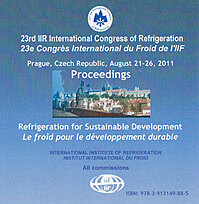
Document IIF
Impact de la masse volumique et de la viscosité sur la performance d'un moteur thermoacoustique avec oscillation de couplage gaz / liquide.
Impact of liquid density and viscosity on the performance of a thermoacoustic engine with gas-liquid coupling oscillation.
Résumé
Gas-liquid coupling oscillation is a novel way to reduce resonant frequency and to elevate pressure amplitude of a thermoacoustic engine, which could be attributed to the increased acoustic inertance by introducing a liquid column into the resonant tube. The performance of a thermoacoustic engine with gas-liquid coupling oscillation could be largely affected by the density and viscosity of liquid, since the acoustic inertance of liquid column is proportional to the liquid density, and the viscous dissipation of liquid column is one of main acoustic power losses in such a system. This paper focuses on the impact of the density and viscosity of liquid on the engine’s performance, i.e., the resonant frequency, pressure amplitude, and hot end temperature of the stack, by numerical simulation. Ambient temperature ionic liquid [EMIM][BF4] and water are respectively chosen as the liquid column in the experiments to validate the simulation.
Documents disponibles
Format PDF
Pages : 6 p.
Disponible
Prix public
20 €
Prix membre*
Gratuit
* meilleur tarif applicable selon le type d'adhésion (voir le détail des avantages des adhésions individuelles et collectives)
Détails
- Titre original : Impact of liquid density and viscosity on the performance of a thermoacoustic engine with gas-liquid coupling oscillation.
- Identifiant de la fiche : 30001627
- Langues : Anglais
- Source : Proceedings of the 23rd IIR International Congress of Refrigeration: Prague, Czech Republic, August 21-26, 2011. Overarching theme: Refrigeration for Sustainable Development.
- Date d'édition : 21/08/2011
Liens
Voir d'autres communications du même compte rendu (569)
Voir le compte rendu de la conférence
-
Resonance conditions of the air column in a the...
- Auteurs : ALIPPI C., D’ORAZIO A., COPPI M., et al.
- Date : 16/06/2013
- Langues : Anglais
- Source : Clima 2013. 11th REHVA World Congress and 8th International Conference on Indoor Air Quality, Ventilation and Energy Conservation in Buildings.
- Formats : PDF
Voir la fiche
-
Vapor pressure measurement of liquid dessicants...
- Auteurs : ZHENG S., HE Y., FU J., et al.
- Date : 18/06/2018
- Langues : Anglais
- Source : 13th IIR Gustav Lorentzen Conference on Natural Refrigerants (GL2018). Proceedings. Valencia, Spain, June 18-20th 2018.
- Formats : PDF
Voir la fiche
-
Evaluation of thermoacoustic cycles for cooling...
- Auteurs : PAEK I., BRAUN J. E., MONGEAU L.
- Date : 17/07/2006
- Langues : Anglais
- Source : 2006 Purdue Conferences. 18th International Compressor Engineering Conference at Purdue & 11th International Refrigeration and Air-Conditioning Conference at Purdue [CD-ROM].
- Formats : PDF
Voir la fiche
-
CFD study of oscillatory flow through 90° bends...
- Auteurs : ILORI O. M., MAO X., JAWORSKI A. J.
- Date : 16/08/2015
- Langues : Anglais
- Source : Proceedings of the 24th IIR International Congress of Refrigeration: Yokohama, Japan, August 16-22, 2015.
- Formats : PDF
Voir la fiche
-
Design and experimentation for thermodynamic an...
- Auteurs : WANKHEDE U. S.
- Date : 21/05/2006
- Langues : Anglais
- Source : ACRA-2006. Proceedings of the 3rd Asian conference on refrigeration and air conditioning.
Voir la fiche
